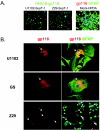Variant-specific tropism of human herpesvirus 6 in human astrocytes
- PMID: 16014907
- PMCID: PMC1181567
- DOI: 10.1128/JVI.79.15.9439-9448.2005
Variant-specific tropism of human herpesvirus 6 in human astrocytes
Abstract
Though first described as a lymphotropic virus, human herpesvirus 6 (HHV-6) is highly neuropathogenic. Two viral variants are known: HHV-6A and HHV-6B. Both variants can infect glial cells and have been differentially associated with central nervous system diseases, suggesting an HHV-6 variant-specific tropism for glial cell subtypes. We have performed infections with both viral variants in human progenitor-derived astrocytes (HPDA) and monitored infected cell cultures for cytopathic effect (CPE), intra- and extracellular viral DNA load, the presence of viral particles by electronic microscopy, mRNA transcription, and viral protein expression. HHV-6A established a productive infection with CPE, visible intracellular virions, and high virus DNA loads. HHV-6B-infected HPDA showed no morphological changes, intracellular viral particles, and decreasing intra- and extracellular viral DNA over time. After long-term passage, HHV-6B-infected HPDA had stable but low levels of intracellular viral DNA load with no detectable viral mRNA. Our results demonstrate that HHV-6A and HHV-6B have differential tropisms and patterns of infection for HPDA in vitro, where HHV-6A results in a productive lytic infection. In contrast, HHV-6B was associated with a nonproductive infection. These findings suggest that HHV-6 variants might be responsible for specific infection patterns in glial cells in vivo. Astrocytes may be an important reservoir for this virus in which differential tropism of HHV-6A and HHV-6B may be associated with different disease outcomes.
Figures






Similar articles
-
Complete replication cycle and acquisition of tegument in nucleus of human herpesvirus 6A in astrocytes and in T-cells.J Med Virol. 2006 Dec;78(12):1542-53. doi: 10.1002/jmv.20737. J Med Virol. 2006. PMID: 17063514
-
Association of human herpesvirus-6B with mesial temporal lobe epilepsy.PLoS Med. 2007 May;4(5):e180. doi: 10.1371/journal.pmed.0040180. PLoS Med. 2007. PMID: 17535102 Free PMC article.
-
Differential HHV-6A gene expression in T cells and primary human astrocytes based on multi-virus array analysis.Glia. 2006 Jun;53(8):789-98. doi: 10.1002/glia.20333. Glia. 2006. PMID: 16541415
-
Molecular biology of human herpesviruses 6A and 6B.Infect Agents Dis. 1993 Dec;2(6):343-60. Infect Agents Dis. 1993. PMID: 8012736 Review.
-
Recent topics related to human herpesvirus 6 cell tropism.Cell Microbiol. 2009 Jul;11(7):1001-6. doi: 10.1111/j.1462-5822.2009.01312.x. Epub 2009 Mar 12. Cell Microbiol. 2009. PMID: 19290911 Review.
Cited by
-
Identifying the culprits in neurological autoimmune diseases.J Transl Autoimmun. 2019 Sep 6;2:100015. doi: 10.1016/j.jtauto.2019.100015. eCollection 2019 Dec. J Transl Autoimmun. 2019. PMID: 32743503 Free PMC article. Review.
-
Efficacy of antiviral compounds in human herpesvirus-6-infected glial cells.J Neurovirol. 2006 Aug;12(4):284-93. doi: 10.1080/13550280600880772. J Neurovirol. 2006. PMID: 16966219
-
Human herpesvirus 6 (HHV-6) induces dysregulation of glutamate uptake and transporter expression in astrocytes.J Neuroimmune Pharmacol. 2008 Jun;3(2):105-16. doi: 10.1007/s11481-007-9084-0. Epub 2007 Sep 8. J Neuroimmune Pharmacol. 2008. PMID: 18247129
-
Human herpesvirus 6 and 7 in febrile status epilepticus: the FEBSTAT study.Epilepsia. 2012 Sep;53(9):1481-8. doi: 10.1111/j.1528-1167.2012.03542.x. Epub 2012 Jun 14. Epilepsia. 2012. PMID: 22954016 Free PMC article.
-
Human herpesvirus 6A infection in CD46 transgenic mice: viral persistence in the brain and increased production of proinflammatory chemokines via Toll-like receptor 9.J Virol. 2014 May;88(10):5421-36. doi: 10.1128/JVI.03763-13. Epub 2014 Feb 26. J Virol. 2014. PMID: 24574405 Free PMC article.
References
-
- Ablashi, D. V., N. Balachandran, S. F. Josephs, C. L. Hung, G. R. Krueger, B. Kramarsky, S. Z. Salahuddin, and R. C. Gallo. 1991. Genomic polymorphism, growth properties, and immunologic variations in human herpesvirus-6 isolates. Virology 184:545-552. - PubMed
-
- Akhyani, N., R. Berti, M. B. Brennan, S. S. Soldan, J. M. Eaton, H. F. McFarland, and S. Jacobson. 2000. Tissue distribution and variant characterization of human herpesvirus (HHV)-6: increased prevalence of HHV-6A in patients with multiple sclerosis. J. Infect. Dis. 182:1321-1325. - PubMed
-
- Albright, A. V., E. Lavi, J. B. Black, S. Goldberg, M. J. O'Connor, and F. Gonzalez-Scarano. 1998. The effect of human herpesvirus-6 (HHV-6) on cultured human neural cells: oligodendrocytes and microglia. J. Neurovirol. 4:486-494. - PubMed
-
- Araque, A., G. Carmignoto, and P. G. Haydon. 2001. Dynamic signaling between astrocytes and neurons. Annu. Rev. Physiol. 63:795-813. - PubMed
Publication types
MeSH terms
LinkOut - more resources
Full Text Sources
Other Literature Sources
Research Materials
Miscellaneous

